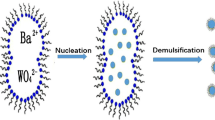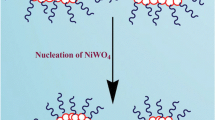Abstract
Nanoscale yttrium–barium–copper oxide (Y2BaCuO5, Y211) particles were synthesized using the emulsion method and the solution method. The basic water-in-oil (w/o) emulsion system consisted of n-octane (continuous oil phase), cetyltrimethylammonium bromide (cationic surfactant), butanol (cosurfactant) and water. The composition of the emulsion system was varied and characterized by measuring the conductivity of the solutions and droplet size. The droplet size of emulsion was determined by using the dynamic light scattering method. The water content, cosurfactant content, and surfactant/n-octane ratio affected the droplet size which was in the range of 3–8 nm, and hence the w/o emulsion system was referred to as a nano-emulsion system. A model was used to verify the droplet size. The influence of salt (Y2(NO3)3) content on the droplet size was investigated and the addition of salt reduced the droplet size. The effects of reaction time and temperature on the Y211 particle sizes were also investigated. The particles were characterized using the TEM, SEM, and XRD. Nanoparticles produced by the nano-emulsion method were calcined at 850°C to form the Y211 phase as compared to solid state processing temperature of 1050°C. Based on the TEM analysis, the average diameter of the Y211 particles produced using the nano-emulsion method was in the range of 30–100 nm. The effect of adding 15% Y211 nanoparticles to the superconductor YBCO-123 as flux pinning centers, was investigated, and the transition temperature was reduced by 3 K.
Similar content being viewed by others
References
Ayyub P., A.N. Maitra, D.O. Shah, 1990. Formation of theoretical-density microhomogeneous YBa2Cu3O7-x using a microemulsion-mediated process. Physica C, 571–579
Ayyub P., Maltra A., Shah D.O., (1993). Microstructure of the CTAB–butanol–octane–water microemulsion system: Effect of dissolved salts. J. Chem. Soc. Faraday Trans. 89: 3585–3589
Bharagava A., Alarco J.A., Mackinnon I.D.R., Yamashita T., (1995). Manufacture of fine grained Y2BaCuO5 powder by co-precipitation. Mater. Lett. 24: 181–188
Bisal S., Bhattacharya P.K., Moulik S.P., (1990). Conductivity study of microemulsions. Dependence of structural behavior of water/oil systems on surfactant, cosurfactant, oil, and temperature. J. Phys. Chem. 94: 350–355
Chow J.C.L., Lo W., Dewhurst C.D., Leung H.T., Cardwell D.A., Shi Y H., (1997). The influence of process parameters on the growth morphology of large-grain Pt-doped YBCO fabricated by seeded peritectic solidification. Supercond. Sci. Technol. 10: 435–443
Clem J.R. (1992). Fundamentals of vortices in the high-temperature superconductors. Supercond. Sci. Technol. 5: S33-S39
Curri M.L., Agostiano A., Manna L., Monica M.D., Catalano M., Chiavarone L., Spagnolo V., Lugara M., (2000). Synthesis and characterization of CdS nanoclusters in a quaternary microemulsion: The role of the cosurfactant. J. Phys. Chem. B 104: 8391–8397
Diko P., Wende C., Litzkendorf T.K., Gawalek W., (1998). The influence of starting YBa2Cu3O7-x particle size and Pt/Ce addition on the microstructure of YBa2Cu3O7-x –Y2BaCuO5 melt processed bulks. Supercond. Sci. Technol. 11: 49–53
Dou S.X., Wang X.L., Guo Y.C., Hu Q.Y., Mikheenko P., Horvat J., Ionescu M., Liu H.K. (1997). Introduction of pinning centers into Bi–(Pb)–Sr–Ca–Cu–O superconductors. Supercond. Sci. Technol. 10:A52–A67
Fang M., Chen Q., Jiao Z., Zhang Q., Wen H., Zhao Z., Cai C. (1997). Influence of Y2BaCuO5 precipitate size on flux pinning effect in melt-texture-growth YBa2Cu3O7-y . Physica C 282–287:2127–2128
Fernández F., Colón C., Durán A., Barajas R., d’Ors A., Becerril M., Llopis J., Paje S.E., Sáez-Puche R., Julián I. (1998). The oxide Y2BaCuO5 as green pigment in ceramics. J. Alloys Compd. 275–277: 750–753
Kan A., Ogawa H., Ohsato H., Ishihara S. (2001). Effects of variations in crystal structure on microwave dielectric properties of Y2BaCuO5 system. J. Eur. Ceram. Soc. 21: 2593–2598
Kan A., Ogawa H., Ohsato H. (2001). Microwave properties of Y2BaCuO5 compound substituted Ni for Cu. Mater. Sci. Eng. B 79:180–182
Kumar P., Pillai V., Shah D.O. (1993). Preparation of Bi–Pb–Sr–Ca–Cu–O oxide superconductors by coprecipitation of nanosize oxalate precursor powders in the aqueous core of water-in-oil microemulsions. Appl. Phys. Lett. 62:765–767
Lee H.S., Lee W., Furubayashi T. (1999). A comparison of coprecipitation with microemulsion methods in the preparation of magnetite. J. App. Phys. 85:5231–5233
Li F, Vipulanandan C., Mohanty K.K. (2003). Microemulsion and solution approaches to nanoparticle iron production for degradation of trichloroethylene. Colloid Surface A 223(1–3):103–112
Li F., Vipulanandan C. (2003). Production and characterization of YBCO nanoparticles. IEEE Trans. Appl. Supercod. 13(2):3196–3198
Murakami M., Gotoh S., Fujimoto H., Yamaguchi K., Koshizuka N., Tanaka S. (1991). Flux pinning and critical currents in melt processed YBaCuO superconductors. Supercond. Sci. Technol. 4: S43–S50
Matsushita T. (2000). Flux pinning in superconducting 123 materials. Supercond. Sci. Technol. 13:730–737
Mathieu J.P., Cano I.G., Koutzarova T., Rulmont A.,Vanderbemden P., Dew-Hughes D., Ausloos M., Cloots R. (2004). The contribution of 211 particles to the mechanical reinforcement mechanism of 123 superconducting single domains. Supercond. Sci. Technol. 17:169–174
Moulik S.P., Aylward W.M., Palepu R. (2001). Phase behavior and conductivity study of water/CPC/alkanol-1-ol (C4 and C5)/1-hexane water/oil microemulsions with reference to their structure and related thermodynamics. Can. J. Chem. 79: 1–12
Nagy J.B., 1999. In: Kumar P., Mittal K.L. eds. Hand Book of Microemulsion Science and Technology. Marcel Dekker, New York, pp. 499–543
Nikolo M. (1993). Flux dynamics in high-temperature superconductors. Supercond. Sci. Technol. 6: 618–623
Palazzo G., Lopez F., Giustini M., Colarfemmina G., Ceglie A., (2003). Role of cosurfactant in the CTAB/water/n-pentanol/n-hexane water-in-oil microemulsion. 1. Pentanol effect on the microstructure. J. Phys. Chem. B 107: 1924–1931
Pecora R., (1995). Dynamic Light Scattering: Applications of Photon Correlation Spectroscopy. Plenum Press, New York
Rondinone A.J., Samia A.S., Zhang Z.J. (2000). A chemometric approach for predicting the size of magnetic spinel ferrite nanoparticles from the synthesis conditions. J. Phys. Chem. B. 104: 7919–7922
Vasylkiv O., Sakka Y., Ka H.B., (2001). Nonisothermal synthesis of Yttria-stabilized zirconia nanopowder through oxalate processing. II. Morphology manipulation. J. Am. Ceram. Soc. 84: 2484–2488
Vipulanandan C., Salib S., (1995). Mechanical and physical-properties of sintered YBCO metal bulk composites with silver powder and fibers. J. Mater. Sci. 30:763–769
Wang Y., Lee J.Y., Deivaraj T.C. (2004). A microemulsion-based preparation of tin/tin oxide core/shell nanoparticles with particle size control. J. Mater. Chem. 14(3):362–365
Wilcoxon J.P., Provencio P.P., (1999). Use of surfactant micelles to control the structural phase of nanosize iron clusters. J. Phys. Chem. B 103: 9809–9812
Yoshida M., Ogawa N., Hirabayashi I., Tanaka S., (1991). Effects of the platinum group element addition on preparation of yttrium barium copper oxide superconductor by melt growth method. Physica C. 185–189: 2409–2410
Zhou L., Chen S.K., Wang K.G., Wu X.Z., Zhang P.X., Feng Y., (2001). Synthesis of ultrafine Y2BaCuO5 powder and its incorporation into YBCO bulk by powder melting process. Physica C 363: 99–106
Acknowledgements
The author would like to thank Dr. M.K. Mironova for helping with the TEM work and related discussion. This work was supported by a grant from the Texas Center for Superconductivity and Advanced Materials (TCSAM) at University of Houston, Houston, Texas.
Author information
Authors and Affiliations
Corresponding author
Rights and permissions
About this article
Cite this article
Li, F., Vipulanandan, C. Characterization of Y2BaCuO5 nanoparticles synthesized by nano-emulsion method. J Nanopart Res 9, 841–852 (2007). https://doi.org/10.1007/s11051-006-9144-z
Received:
Accepted:
Published:
Issue Date:
DOI: https://doi.org/10.1007/s11051-006-9144-z




